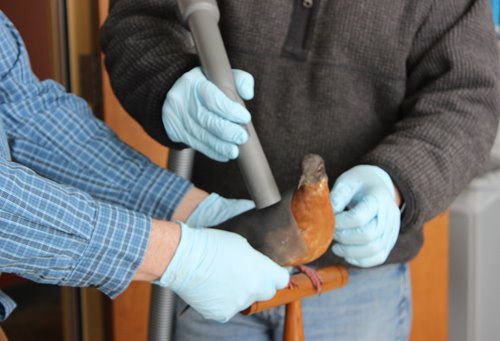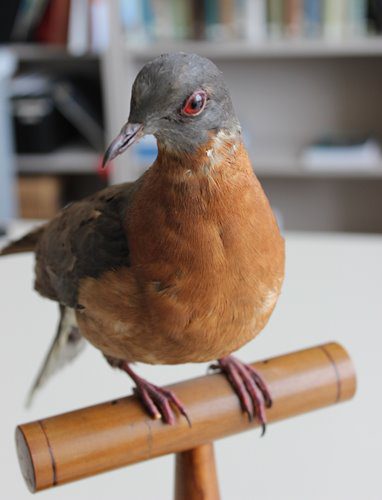In a post in this blog last year I talked about how we vacuumed our passenger pigeon mount “Buttons” for the upcoming exhibit “Transformation“, followed shortly by the exhibit “Going, Going, Gone? Endangered and Extinct Species“. I thought that would be a once-in-a-career event, but last week I got to vacuum yet another passenger pigeon!

Carefully vacuuming the Passenger Pigeon
This is a beautiful mount that we have on loan to the Cincinnati Zoo, where it has been displayed for many years. Since the Cincinnati Zoo is where the very last passenger pigeon lived and died (Martha – who is now at the Smithsonian), it seems appropriate that we loan one of our passenger pigeons to the Zoo. This mount was housed for years in the Zoo’s Passenger Pigeon Memorial building, which was renovated this year. Our specimen is being moved to another building at the Zoo, so this was a good time to go and check on the mount and to clean it. We wanted to be sure that such an important specimen was to be housed in good conditions. The new building is air-conditioned, has low light levels, and the bird will be installed in its own sealed, insect-proof display case.
 Using the same technique that we used on Buttons, we cleaned this mount using a special adjustable, low-suction HEPA vacuum. To keep the feathers from ruffling, we carefully placed a piece of flexible, non-metallic screening over a small section of the mount at a time. Then applied the suction, which draws the dust and arsenic directly off the bird. Yes, arsenic! Buttons and most other old taxidermy specimens have arsenic in them. It was applied as a method to keep insect pests off the taxidermy mounts, and it worked! Although it wasn’t too good for the taxidermists (and present-day curators!). It was used from the late 19th Century until about the 1960’s. We consider any older mount as having arsenic present unless we test for it and get a negative result.
Using the same technique that we used on Buttons, we cleaned this mount using a special adjustable, low-suction HEPA vacuum. To keep the feathers from ruffling, we carefully placed a piece of flexible, non-metallic screening over a small section of the mount at a time. Then applied the suction, which draws the dust and arsenic directly off the bird. Yes, arsenic! Buttons and most other old taxidermy specimens have arsenic in them. It was applied as a method to keep insect pests off the taxidermy mounts, and it worked! Although it wasn’t too good for the taxidermists (and present-day curators!). It was used from the late 19th Century until about the 1960’s. We consider any older mount as having arsenic present unless we test for it and get a negative result.
 So look for our passenger pigeon mount to reappear soon at the Cincinnati Zoo. Also if you visit the Education Building at the Zoo, you’ll see this awesome flock of passenger pigeons! Each one is hung from a fine filament and when you walk past the flock they actually move and you can hear the wings “fluttering”. It’s part of the nationwide Fold the Flock project which is trying to symbolically recreate the huge flocks of passenger pigeons that once darkened our skies. You can fold the origami birds available in our “Going, Going, Gone?” exhibit, or go to the Flock the Flock website to download your own free origami paper or purchase a kit of 50 origami pages. But be sure to go back to the website and record how many birds you folded for the virtual flock. They’ve already tallied over a million birds!
So look for our passenger pigeon mount to reappear soon at the Cincinnati Zoo. Also if you visit the Education Building at the Zoo, you’ll see this awesome flock of passenger pigeons! Each one is hung from a fine filament and when you walk past the flock they actually move and you can hear the wings “fluttering”. It’s part of the nationwide Fold the Flock project which is trying to symbolically recreate the huge flocks of passenger pigeons that once darkened our skies. You can fold the origami birds available in our “Going, Going, Gone?” exhibit, or go to the Flock the Flock website to download your own free origami paper or purchase a kit of 50 origami pages. But be sure to go back to the website and record how many birds you folded for the virtual flock. They’ve already tallied over a million birds!